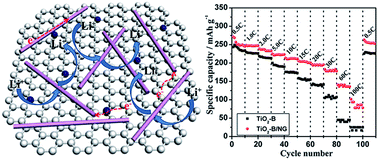Ultrafast lithium storage in TiO2–bronze nanowires/N-doped graphene nanocomposites
Abstract
A TiO2–bronze/N-doped graphene nanocomposite (TiO2–B/NG) is prepared by a facile hydrothermal combined with hydrazine monohydrate vapor reduction method. The material exhibits macro- and meso-porosity with a high specific surface area of 163.4 m2 g−1. X-Ray photoelectron spectroscopy confirms the successful doping of nitrogen in the graphene sheets. In addition, the TiO2–B nanowires are substantially bonded to the NG sheets. Cyclic voltammetry and electrochemical impedance spectroscopy show that the N-doped graphene improves the electron and Li ion transport in the electrode which results in better electrochemical kinetics than that of the pristine TiO2–B nanowires. As a result, the charge transfer resistance of the TiO2–B/NG electrode is significantly reduced. In addition, the lithium diffusion coefficient of TiO2–B/NG increases by about five times with respect to that of pristine TiO2–B. The TiO2–B/NG composite exhibits a remarkably enhanced electrochemical performance compared to that of TiO2–B. It shows a discharge capacity of 220.7 mA h g−1 at the 10C rate with a capacity retention of 96% after 1000 cycles. In addition, it can deliver a discharge capacity of 101.6 mA h g−1 at an ultra high rate of 100C, indicating its great potential for use in high power lithium ion batteries.


 Please wait while we load your content...
Please wait while we load your content...